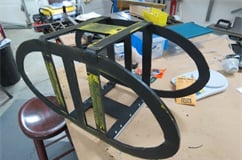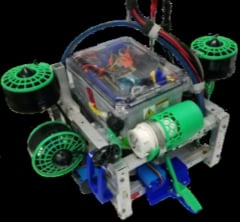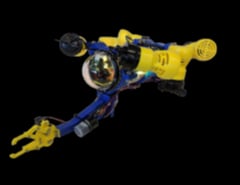Interesting bits: You can cut HDPE plastic with a PVC cutter!
Compiled by: Jim McDonnell, P.E., MATE Engineering Instructor


Whether you're a novice or an old-hand at building an ROV, there is - without fail - a moment at competition when you see something and think: "Why didn't we think of that?".
We at MATE have collected a handy little pile of Tips, Tricks, and Hacks to help improve your ROV experience.
Those little things that you learn along the way that you sort of wish you'd known at the very beginning.
What: A good frame material for new teams is ½ inch PVC pipe and fittings. Intermediate teams may want to move to creating their frame from HDPE (high-density Polyethylene) cut into strips and fastened together. Advanced teams often custom cut and shape HDPE, aluminum, or 3D print plastics to create a frame or attachment points.
Who: MATE Staff
ROV System: Frame
Competition Class: ALL
When: Any time
Pros: Lighter weight, more construction options
Cons: More difficult construction, more expensive and potentially harder to find
MATE Insights: The frame material you use should depend on the construction skills of the team, the tools available to the team, and funds on hand to construct the vehicle. For some missions, the physical properties of the materials might be important as well.
Most teams starting out use PVC pipe for their ROV frames. PVC is ideal as it is readily available, inexpensive, and easy to cut. The same PVC pieces can be reused for many years, although users should note that PVC can become brittle if left in the sun for long periods of time. However, PVC does not paint well, and although colored PVC is available, it is costly. PVC with water inside the pipe also adds a lot of mass to the ROV.
Here are some other options we've seen competitors use through the years:

HDPE: HDPE (high-density polyethylene - think your plastic kitchen cutting board). HDPE is naturally buoyant and can be bent if it is heated with a heat gun. HDPE can also be easily cut and drilled by hand. HDPE requires mechanical fasteners (pan head machine screws with lock nuts or rivets work well) to connect one piece to another. Don’t use glues, epoxy, or paint on HDPE. These will not adhere to the plastic. The “stick built” HDPE frame is an easy way for teams to starting building HDPE frames and only requires a hand drill. The “stick built” method involves a ¼ inch thick HDPE sheet precut into ½ wide strips of various lengths (45, 35, 30,and 20 centimeters). Teams can bolt together the sticks to make their frame. HDPE can typically be purchased at local plastic stores. It might also be available at sign stores. Finding HDPE sheets locally can be more economical than purchasing HDPE off the web and paying shipping costs. Often local plastic stores have scrap pieces that they will sell you by the pound.
If you have intermediate to advanced building skills and tools, HDPE may be a good option for your frame. You can use hand tools or even a C-N-C machine to cut HDPE sheets into the required shapes. Some frames are constructed from a single piece of HDPE and bent with heat. This reduces the number of fasteners needed to construct the frame. One common error when using HDPE is cutting the plas4tic too thick (over ½ inches wide). This may result in a heavier frame.

Aluminum: Aluminum is light, strong, inexpensive, and readily available. Typically “U channel” or angle aluminum is used, though one clever team used aluminum tent poles with 3D printed connectors. Think creatively! One potential issue is that aluminum frames can be more difficult to manufacture and modify. Often, aluminum frames are limited to rectangular shapes. Aluminum frames typically weigh less than HDPE frames.

3D Printing: 3D printing the entire frame out of PLA (polylactic acid – 3D printing filament) means you can create your frame to any size and shape. Some 3D printed frames incorporate their waterproof housing and other system connections as a structural component. 3D printed ROVs tend to be compact and nimble.
Additional Tip: MATE does not recommend construction a frame out of acrylic (plexiglass). Acrylic can shatter if it is dropped or if it is roughly handled during travel or shipping.
References: Technical reports: Northern Ozaukee HIgh School, Aptos High School, Drexel University
Search Terms: HDPE Brands - Seaboard, Starboard, Marine Board
Fun Idea: Need a frame for a mini ROV? Use 1/4 inch plastic irrigation drip line
Compiled by: Jim McDonnell, P.E., MATE Engineering Instructor
What: Teams have damaged their control systems by shorting wires while attempting to solder connections with the power still on.
Who: There've been a few - we won't name names
ROV System: Control
Competition Class: ALL
POTENTIAL SAFETY HAZARD or damaged controls
MATE Insights: When soldering wires, the power in those circuits should ALWAYS be turned off and unplugged. In general, power should always be turned off to all exposed circuits when repairing or working on them. This protects the circuit from accidental shorts from tools, wires, solder and body parts. Care, diligence, and awareness are required for troubleshooting live circuits with meters to avoid shorts. Smoke from some burnt electronic components can be harmful and the work areas should be cleared of any smoke before reengaging with the work item.
Interesting bits: It is sometimes joked that electronics run on “magic smoke” moving inside the wires. If you let the smoke out of the wires, the circuit stops working. In reality, “letting the smoke out” or “the smoke of shame” means you burned up a component, causing it to burn and smoke. This is usually due to a short circuit.
Compiled by: Jim McDonnell, P.E., MATE Engineering Instructor
What: Servos and cameras advertised as IP68 waterproof often fail with continual ROV underwater use and depths over one meter.
Who: MATE Staff
ROV Systems: Payload and video
Competition Class: ALL
Pros: Inexpensive parts, available through many online stores
Cons: Difficult to tell which products may fail with longer ROV use underwater and increasing depths.
MATE Insights: An IP (ingress protection) rating only guarantees a product is waterproof under certain conditions (application, depths, and durations). The manufacturer can specify some of these conditions and have an IP68 waterproof product even though the product may FAIL on your ROV. One manufacture’s product may be IP68 waterproof to a depth of 5 meters, while another product may be IP68 waterproof to a depth of 1 meter. This may be annoying since initially a product will work on the ROV, but over time water may leak into the component, causing it to fail. It is best to clarify with the manufacture exactly what their “IP68 waterproof” specifications are. Even better, test the purchased products to determine its waterproof parameters over time.
Do NOT assume products that are IP68 will work on your ROV without testing them at your operating depths for extended periods of time!
References: https://en.wikipedia.org/wiki/IP_Code
Search Words: Waterproof hobby servo, waterproof car backup camera
Compiled by: Jim McDonnell, P.E., MATE Engineering Instructor
What: Saw-tooth profiles to improve probe design
Who: Bolsa Knolls Middle School - Salinas, CA
ROV System: Payload
Competition Class: ALL
Pros: Quick to make out of HDPE (high-density polyethylene)
Cons: Might produce sharp edges, which would be a safety violation; be sure to smooth any sharp edges
MATE Insights: Every ROV should have a simple static probe as a mission tool to pick up items and bring them to the surface. A simple saw-tooth profile works very well because it can maneuver under items and hang onto them. The ROV typically pitches downward (nose goes down) when you are lifting an object at the front of the vehicle. The tooth design holds the item onto the probe, whereas an object often will roll/fall off of a smooth probe if the ROV pitches downward during a lift. The saw-tooth profile probes can have multiple teeth or a single tooth. The height of the teeth and whether they are angular or rounded all depends on the material you are picking up.

Saw-Tooth Probe - objects stay on

Smooth Probe- objects fall off
Interesting bits: You can cut HDPE plastic with a PVC cutter!
Compiled by: Jim McDonnell, P.E., MATE Engineering Instructor
What: Duct tape or electrical tape eventually unravel with constant immersion in water. Self-fusing silicone tape is better for use underwater and will not unravel.
![]()
Who: MATE Staff
ROV System: Multiple
Competition Class: ALL
Pros: Self-fusing silicone tape is very strong, easy to work with, readily available, and a good electrical insulator
Cons: Single use and costs more than duct or electrical tape
MATE Insights: Self-fusing silicone tape is really cool stuff and can be applied over wet surfaces. Since it fuses to itself, you simply stretch the tape as you wrap it. This tape is great for making those emergency tether repairs, whipping the flex casing on your tether ends, or attaching wires to your frame. The tape is available at most local hardware and home building stores, as well as online sources.
Search Terms: X-Treme tape, Rescue Tape, Fixit Tape, and Miracle Wrap
Interesting bits: Comes in a lot of colors
Compiled by: Jim McDonnell, P.E., MATE Engineering Instructor
What: You have worked hard on your ROV build project over many months. Had some fun, maybe an odd tear, but in general, had some fun and made a great team entry.
Tell us about it!!
Please don't skimp on telling the judges about the great work you have done. Otherwise you risk giving easy points away. The following guide is based around MATE judges' observations for simple improvements over recent years‐ and hopefully will provide some help to avoid dropping easy points.
All so often ....the report is missing the perfect story‐ but judges see "between the lines" is evidence of a fantastic piece of work and great technical results.
Here are some hopefully helpful tips to be used as a guide. Have fun!
Competition Class: EXPLORER
Compiled by: Neil Stagg IMechE, CE, FSUT
Cunning things we've seen poolside through the years. This is where our Sharkpedo Teams would rule supreme!
What: Achieve easier movement of toggle switches on your control box by extending the length of the switch arms using corks or wooden dowels.
Who: Bolsa Knolls Middle School - Salinas, CA
ROV System: Controls
Competition Class: SCOUT
Pros: Easy to do and very low cost
Cons: May fall off
MATE Insight: Although this might look a little funny, the added leverage makes pushing the switches much easier. When using these add-ons, the controller may seem like a totally new kind of control box. This can be used on the SeaMATE AngelFish ROV kits.

Interesting bits: If you fancy that knobby, old-school joystick feel, you can use champagne corks!
Compiled by: Jim McDonnell, P.E., MATE Engineering Instructor
Those down-and-dirty solutions to ROV problems. It might not be the prettiest thing you've seen, but it works!
What: Rigid foam insulation is an inexpensive buoyancy material for MATE ROVs that do NOT go deeper than 30 feet and can be found at most home building supply stores.
Who: MATE Staff
ROV System: Buoyancy
Competition Class: NAVIGATOR, RANGER, and EXPLORER (see notes on depth)
Pros: Inexpensive, readily available, can be cut into many shapes, will not absorb water, and can be hand painted.
Cons: Cannot be spray painted (spray propellants melt the foam) and is limited to 30 feet of depth or less.
MATE Insights: Most beginning ROV teams use pool noodles for buoyancy and in a few feet of water for short periods of time pool noodles are great. The variety of colors can be fun too! However, at deeper depth and longer durations, pool noodles will compress and get soggy, which results in a loss of their buoyant forces. Rigid foam insulation does not compress, nor will it absorb water and become soggy.
In the US there are two primary manufactures of rigid foam insulation (closed cell foam made from Extruded Polystyrene (XPS)) that is readily available at most home supply stores: Owen Corning makes the FOAMULAR products and Dow makes Styrofoam Utilityfit products, often called Blue Board. The material can be typically purchased in a precut 2 ft X 2 ft sheet for under $6 USD or in 4 ft X 8 ft sheets for under $35 USD.There are other rigid foam manufactures and the key specifications to understand for ROV buoyancy material are: compression strength and water absorption.
Compression strength is defined as the pressure (depth) at which the material deflects (compresses) 10% resulting in roughly 90% of its original volume and buoyancy force remaining. Water absorption is the increase in weight the foam will gain after it has been immersed in water for a specific period of time. Both the Owens Corning and DOW products have a compression strength of 15-25 psi (remember 30 ft (10 meters) of water = approximately 15 psi (1bar) pressure) and a minuscule water absorption rating. Both are acceptable for the normal flight envelope of a MATE ROV.
There are other commercially available buoyancy foams such as, R3312, that will allow your ROV to go deeper and run longer but they are more expensive and available from fewer suppliers. In addition, some advanced teams pour their own foam into custom molds and then cover it with epoxy paint. This looks cool and very professional.When purchasing rigid foam insulation think blue or pink. Do not buy regular white foam, it generally does not meet the above ratings.

Search Terms: Rigid foam insulation, Foamular, Blue Board
Interesting bits: Open cell foams contain air spaces that absorb water (think of a kitchen sponge).
Compiled by: Jim McDonnell, P.E., MATE Engineering Instructor
What: Use a digital aquarium thermometer to measure water temperature with your ROV
Who: MATE Summer Institute
ROV System: Payload and Instrumentation
Competition Class: ALL
Pros: Inexpensive, readily available from web stores, reads in Celsius.
Cons: Battery can run out. Accuracy can be sketchy, be sure to calibrate

MATE Insights: Using a digital aquarium thermometer is an easy and inexpensive method to measure water temperature on your ROV. This type of thermometer can be easily extended by cutting the cable and extending it with additional wire (soldering is required). There are two wires in the cable that need to be extended. The extension should match the length of your tether. Since at least one of these connections will likely be underwater, make sure you waterproof any soldering connections. After extending the line you should test the instrument for accuracy and to make sure you have waterproof connections.
Search Terms: Digital aquarium thermometer
Interesting Bits: You can build your own using an LM35 chip
Compiled by: Jim McDonnell, P.E., MATE Engineering Instructor
